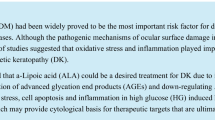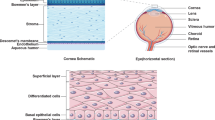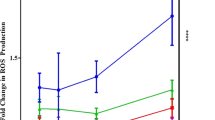Abstract
Background
The purpose of the experiment reported here was to assess the involvement of advanced glycation end products (AGEs), oxidative stress, and nuclear factor kappa-B (NF-κB) activation in the development of diabetic keratopathy.
Methods
Diabetes was induced by intraperitoneal streptozotocin injection in male Sprague–Dawley rats. The thickness of the cornea was measured. Apoptosis was detected by TUNEL assay and western blot for caspase-3. The expression of AGEs and 8-hydroxydeoxyguanosine (8-OHdG) were studied by immunohistochemistry in corneal tissues of normoglycaemic and diabetic rats. NF-κB activation was evaluated by electrophoretic mobility shift assay and southwestern histochemistry.
Results
Corneal edema was observed in diabetic rats. The thickness of cornea was higher in diabetic than in control rats. AGEs were accumulated in corneal tissues. 8-OHdG and NF-κB were identified in corneal epithelium, stroma and endothelium, and its expressions were greater in diabetic than in those of control rats. Diabetes induces significant alterations in rat corneal tissue structure.
Conclusions
The higher expression of AGE, 8-OHdG and NF-κB in corneal tissues of diabetic rats suggests that these factors are involved in apoptosis and in subsequent corneal alterations related to diabetic keratopathy.





Similar content being viewed by others
References
Robertson RP (2004) Chronic oxidative stress as a central mechanism for glucose toxicity in pancreatic islet beta cells in diabetes. J Biol Chem 279:42351–42354
Rolo AP, Palmeira CM (2006) Diabetes and mitochondrial function: role of hyperglycemia and oxidative stress. Toxicol Appl Pharmacol 212:167–178
Azar DT, Spurr-Michaud SJ, Tisdale AS, Gipson IK (1992) Altered epithelial-basement membrane interactions in diabetic corneas. Arch Ophthalmol 110:537–540
Friend J, Ishii Y, Thoft RA (1982) Corneal epithelial changes in diabetic rats. Ophthalmic Res 14:269–278
Taylor HR, Kimsey RA (1981) Corneal epithelial basement membrane changes in diabetes. Invest Ophthalmol Vis Sci 20:548–553
Brightbill FS, Myers FL, Bresnick GH (1978) Postvitrectomy keratopathy. Am J Ophthalmol 85:651–655
Foulks GN, Thoft RA, Perry HD, Tolentino FI (1979) Factors related to corneal epithelial complications after closed vitrectomy in diabetics. Arch Ophthalmol 97:1076–1078
Goebbels M, Spitznas M (1991) Endothelial barrier function after phacoemulsification: a comparison between diabetic and non-diabetic patients. Graefes Arch Clin Exp Ophthalmol 229:254–257
Perry HD, Foulks GN, Thoft RA, Tolentino FI (1978) Corneal complications after closed vitrectomy through the pars plana. Arch Ophthalmol 96:1401–1403
Kaji Y, Usui T, Oshika T, Matsubara M, Yamashita H, Araie M, Murata T, Ishibashi T, Nagai R, Horiuchi S, Amano S (2000) Advanced glycation end products in diabetic corneas. Invest Ophthalmol Vis Sci 41:362–368
Yucel I, Yucel G, Akar Y, Demir N, Gurbuz N, Aslan M (2006) Transmission electron microscopy and autofluorescence findings in the cornea of diabetic rats treated with aminoguanidine. Can J Ophthalmol 41:60–66
Ahmed N (2005) Advanced glycation endproducts—role in pathology of diabetic complications. Diabetes Res Clin Pract 67:3–21
Brownlee M (1995) Advanced protein glycosylation in diabetes and aging. Annu Rev Med 46:223–234
Romeo G, Liu WH, Asnaghi V, Kern TS, Lorenzi M (2002) Activation of nuclear factor-kappaB induced by diabetes and high glucose regulates a proapoptotic program in retinal pericytes. Diabetes 51:2241–2248
Kaji Y, Amano S, Usui T, Oshika T, Yamashiro K, Ishida S, Suzuki K, Tanaka S, Adamis AP, Nagai R, Horiuchi S (2003) Expression and function of receptors for advanced glycation end products in bovine corneal endothelial cells. Invest Ophthalmol Vis Sci 44:521–528
Kasper M, Roehlecke C, Witt M, Fehrenbach H, Hofer A, Miyata T, Weigert C, Funk RH, Schleicher ED (2000) Induction of apoptosis by glyoxal in human embryonic lung epithelial cell line L132. Am J Respir Cell Mol Biol 23:485–491
Yamagishi S, Inagaki Y, Amano S, Okamoto T, Takeuchi M, Makita Z (2002) Pigment epithelium-derived factor protects cultured retinal pericytes from advanced glycation end product-induced injury through its antioxidative properties. Biochem Biophys Res Commun 296:877–882
Sady C, Khosrof S, Nagaraj R (1995) Advanced Maillard reaction and crosslinking of corneal collagen in diabetes. Biochem Biophys Res Commun 214:793–797
Araki N, Ueno N, Chakrabarti B, Morino Y, Horiuchi S (1992) Immunochemical evidence for the presence of advanced glycation end products in human lens proteins and its positive correlation with aging. J Biol Chem 267:10211–10214
Marion MS, Carlson EC (1994) Immunoelectron microscopic analyses of Maillard reaction products in bovine anterior lens capsule and Descemet’s membrane. Biochim Biophys Acta 1191:33–42
Gul M, Emre S, Esrefoglu M, Vard N (2008) Protective effects of melatonin and aminoguanidine on the cornea in streptozotocin-induced diabetic rats. Cornea 27:795–801
Sohn EJ, Kim CS, Kim YS, Jung DH, Jang DS, Lee YM, Kim JS (2007) Effects of magnolol (5, 5′-diallyl-2, 2′-dihydroxybiphenyl) on diabetic nephropathy in type 2 diabetic Goto–Kakizaki rats. Life Sci 80:468–475
Kim J, Kim CS, Sohn E, Kim H, Jeong IH, Kim JS (2010) Lens epithelial cell apoptosis initiates diabetic cataractogenesis in the Zucker diabetic fatty rat. Graefes Arch Clin Exp Ophthalmol 248:811–818
Sato E, Mori F, Igarashi S, Abiko T, Takeda M, Ishiko S, Yoshida A (2001) Corneal advanced glycation end products increase in patients with proliferative diabetic retinopathy. Diab Care 24:479–482
Singh R, Barden A, Mori T, Beilin L (2001) Advanced glycation end-products: a review. Diabetologia 44:129–146
Vlassara H, Bucala R, Striker L (1994) Pathogenic effects of advanced glycosylation: biochemical, biologic, and clinical implications for diabetes and aging. Lab Invest 70:138–151
Alves M, Calegari VC, Cunha DA, Saad MJ, Velloso LA, Rocha EM (2005) Increased expression of advanced glycation end-products and their receptor, and activation of nuclear factor kappa-B in lacrimal glands of diabetic rats. Diabetologia 48:2675–2681
Roszkowska AM, Tringali CG, Colosi P, Squeri CA, Ferreri G (1999) Corneal endothelium evaluation in type I and type II diabetes mellitus. Ophthalmologica 213:258–261
Take G, Karabay G, Erdogan D, Duyar I (2006) The ultrastructural alterations in rat corneas with experimentally-induced diabetes mellitus. Saudi Med J 27:1650–1655
Denis U, Lecomte M, Paget C, Ruggiero D, Wiernsperger N, Lagarde M (2002) Advanced glycation end-products induce apoptosis of bovine retinal pericytes in culture: involvement of diacylglycerol/ceramide production and oxidative stress induction. Free Radic Biol Med 33:236–247
Kislinger T, Fu C, Huber B, Qu W, Taguchi A, Du Yan S, Hofmann M, Yan SF, Pischetsrieder M, Stern D, Schmidt AM (1999) N(epsilon)-(carboxymethyl)lysine adducts of proteins are ligands for receptor for advanced glycation end products that activate cell signaling pathways and modulate gene expression. J Biol Chem 274:31740–31749
Hofmann MA, Drury S, Fu C, Qu W, Taguchi A, Lu Y, Avila C, Kambham N, Bierhaus A, Nawroth P, Neurath MF, Slattery T, Beach D, McClary J, Nagashima M, Morser J, Stern D, Schmidt AM (1999) RAGE mediates a novel proinflammatory axis: a central cell surface receptor for S100/calgranulin polypeptides. Cell 97:889–901
Beckman KB, Ames BN (1997) Oxidative decay of DNA. J Biol Chem 272:19633–19636
Klocek MS, Sassani JW, McLaughlin PJ, Zagon IS (2007) Topically applied naltrexone restores corneal reepithelialization in diabetic rats. J Ocul Pharmacol Ther 23:89–102
Kowluru RA (2005) Effect of advanced glycation end products on accelerated apoptosis of retinal capillary cells under in vitro conditions. Life Sci 76:1051–1060
Yanagiya N, Akiba J, Kado M, Yoshida A, Kono T, Iwamoto J (1997) Transient corneal edema induced by nitric oxide synthase inhibition. Nitric Oxide 1:397–403
Pepose JS, Ubels JL (1992) The cornea. In: Hart WM Jr (ed) Adler’s physiology of the eye. Mosby, St. Louis, pp 53–58
Waring GO 3rd, Bourne WM, Edelhauser HF, Kenyon KR (1982) The corneal endothelium. Normal and pathologic structure and function. Ophthalmology 89:531–590
Wigham CG, Guggenheim JA, Hodson SA (1994) Sodium movement into and out of corneal endothelium. Pflugers Arch 428:577–582
Agardh CD, Stenram U, Torffvit O, Agardh E (2002) Effects of inhibition of glycation and oxidative stress on the development of diabetic nephropathy in rats. J Diabetes Complications 16:395–400
Nicholls K, Mandel TE (1989) Advanced glycosylation end-products in experimental murine diabetic nephropathy: effect of islet isografting and of aminoguanidine. Lab Invest 60:486–491
Osicka TM, Yu Y, Panagiotopoulos S, Clavant SP, Kiriazis Z, Pike RN, Pratt LM, Russo LM, Kemp BE, Comper WD, Jerums G (2000) Prevention of albuminuria by aminoguanidine or ramipril in streptozotocin-induced diabetic rats is associated with the normalization of glomerular protein kinase C. Diabetes 49:87–93
Kern TS, Tang J, Mizutani M, Kowluru RA, Nagaraj RH, Romeo G, Podesta F, Lorenzi M (2000) Response of capillary cell death to aminoguanidine predicts the development of retinopathy: comparison of diabetes and galactosemia. Invest Ophthalmol Vis Sci 41:3972–3978
Peponis V, Papathanasiou M, Kapranou A, Magkou C, Tyligada A, Melidonis A, Drosos T, Sitaras NM (2002) Protective role of oral antioxidant supplementation in ocular surface of diabetic patients. Br J Ophthalmol 86:1369–1373
Kalfa TA, Gerritsen ME, Carlson EC, Binstock AJ, Tsilibary EC (1995) Altered proliferation of retinal microvascular cells on glycated matrix. Invest Ophthalmol Vis Sci 36:2358–2367
Moore TC, Moore JE, Kaji Y, Frizzell N, Usui T, Poulaki V, Campbell IL, Stitt AW, Gardiner TA, Archer DB, Adamis AP (2003) The role of advanced glycation end products in retinal microvascular leukostasis. Invest Ophthalmol Vis Sci 44:4457–4464
Stitt AW, Moore JE, Sharkey JA, Murphy G, Simpson DA, Bucala R, Vlassara H, Archer DB (1998) Advanced glycation end products in vitreous: structural and functional implications for diabetic vitreopathy. Invest Ophthalmol Vis Sci 39:2517–2523
Acknowledgments
This research was supported by a grant [L08010, K09030] from the Korea Institute of Oriental Medicine (KIOM).
Author information
Authors and Affiliations
Corresponding author
Rights and permissions
About this article
Cite this article
Kim, J., Kim, CS., Sohn, E. et al. Involvement of advanced glycation end products, oxidative stress and nuclear factor-kappaB in the development of diabetic keratopathy. Graefes Arch Clin Exp Ophthalmol 249, 529–536 (2011). https://doi.org/10.1007/s00417-010-1573-9
Received:
Revised:
Accepted:
Published:
Issue Date:
DOI: https://doi.org/10.1007/s00417-010-1573-9




